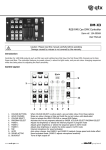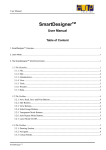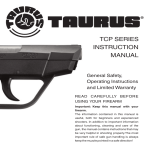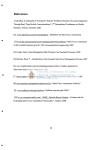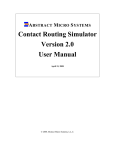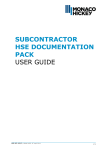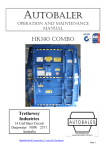Download THE MANAGEMENT OF MAINTENANCE
Transcript
THE M A N A G E M E N T O F M A IN T E N A N C E SETTING UP ROUTINES AND FAULT REPORTING SYSTEMS Is maintenance and repair of hospital equipment a problem at your hospital? The breakdown of a piece of equipment is inconvenient to us and can put our patients’ lives at risk. The result is frustration and stress. Sometimes a breakdown is inevitable or a repair is delayed because a spare part is not available or an expert is required to identify and repair the fault. Is maintenance of c‘<|iii]>nit*nl <1 problem ill your hospital? • is care of pal Units affected? • does it cause frustration to staff? • does il endanger patients? • I m w I i hi j i d m ‘S il l.iki- Id t■(11ii|ini<>i11 rcp.iiivd'.’ If maintenance is a problem, what is the cause? Every hospital has some kind of system by which broken or faulty equipment is repaired. But it is not always efficient. There may be several reasons for this. It may be that: the hospital has outgrown the system the policy has been changed newly appointed staff have not been adequately briefed simple repair jobs are sent away unnecessarily repaired items are not collected promptly a fault is not reported even when identified W hat is the maintenance problem? • do you have a maintenance system? • • do all staff members know to whom to report equipment faults? is there a staff member trained in maintenance anti repair of • • who decides when an item needs to be sent away for repair? are there spares available? • if so, does everyone know where spares are kept? Should something be done about the problem? The problem may have one or more causes but is it a priority? All hospital services, especially those which affect treatment and welfare of patients, should be reviewed on a regular basis. Where a problem is identified, it should have priority. l)<K‘s your hospital iiit i ! lo rhaugr ils system of <'<|iii|>nu‘iil mniiilriiiiiHv? • is 111<■ |»r*ililf-in ;i si-rim is i i h • I it >\ \d o rs llu- priibli'm idiiip.H f with h H h t s 1.’ • is there an easy solution to it? ________________________________________________ > ^ \ If maintenance of equipment is a problem, two routine procedures can reduce the number of times equipment breaks down and the length of time it takes to get it into service again. They are: correct and careful operation of equipment by all users an efficient fault-reporting and simple repair service within the hospital itself How can the use, maintenance and repair of hospital equipment be improved? Whether or not you think the use, maintenance and repair of hospital equipment is a problem in your hospital or health centre, the topic should be discussed at regular intervals with all those involved. In this way, any problem which does arise can be dealt with at an early stage. When a problem is identified, it should be discussed and a plan for change agreed upon. The solution should include targets to be reached by certain dates (e.g. equipment will be repaired within a specific number of days from the time of fault reporting), making individuals responsible for action. Every action taken should be recorded and each step of the system monitored. Performance can then be reviewed regularly and new standards set if necessary. I low lo in ip n n e Ihr use. maintenance am i repair of equipment: • • pul Ih*■subject on III** m .u ia ^fiiiriil agenda identity llie i)i«»l)lc‘ii i i s ) • • plan change to solve the problem set targets and dates • • • implement change supervise anil m o n ito r ihe changed system report back and review • re-set targets if necessary Why keep records? When a record is kept of each stage of this procedure and its outcome, it enables: - ward/department staff to follow up the process of repair of their equipment an identified staff member responsible for maintenance to monitor the repair process and account for the piece of equipment at any stage management to set and monitor the attainment of targets management to produce monthly and quarterly reports on the efficiency of the system management to review the maintenance and repair system at regular intervals and to identify any problems with it Communication Good communication is an essential element of good management and is of great importance in the management of change. First, the management team must be involved and then all members of the hospital staff. The following steps should be taken: 1. Clarify the problem: Identify with the management team just what the problem is. Consult with them. Get colleagues to state how they see the present system; what difficulties they have with getting equipment repaired; the life-span of a piece of equipment. Are items frequently out of service and, if so, why? What are their solutions to the problem? 2. Gain the co-operation of all those affected: All staff members are affected by change. Persuade people to speak freely, listen to them and give credit to the ideas expressed. Lead meetings effectively. 3. Transmit the decision to bring about change: The more staff you involve in making change, the fewer problems you will have in implementing it. Plan how to communicate the proposed new system and gain the co-operation which you require from all your staff to make it a success. 4. Motivate people to carry out the change: Tell staff members what you expect of them. Show them how their personal objectives (good care and safe, effective treatment of their patients) are related to the proposed change. 5. Evaluate the impact of your communication: Assess the effectiveness of meetings. Are people discussing among themselves? Do all staff members understand their own contributions to making the new system work? Do they understand and have they accepted the responsibilities of the newly authorised maintenance staff member as suggested below? Has the care and safety of equipment taken on a new importance throughout your hospital? A suggested model for an effective maintenance and repair system You may have a maintenance and repair system which is very simple. For example, from a field-test of the first chapters of this book, we learned of one hospital in which the ward or departmental staff reported the equipment breakdown or fault to the matron, who filled in a repair request and sent it to the storeman who assigned a hospital handyman to repair the fault immediately. In a small hospital with a limited amount of equipment, this simple practice can work well. From other responses to the field-test, we learned that often there is no system and staff rely on a village handyman or have to send the faulty equipment hundreds of kilometres away for repair. Others reported long delays between fault-reporting and fault-repairing or confusion regarding the person who was responsible for maintenance and repair in their hospitals. If this is close to your own situation, then our suggested model for a maintenance and repair system may be used either to adapt or to replace your existing one. The majority of hospitals have one person on the management team who is responsible for the maintenance of the hospital’s equipment. In our suggested model he or she identifies someone on the hospital staff to be responsible for organising the maintenance of equipment - the title of the person identified will be Maintenance Officer. This will be someone who is literate - such as a nurse or a laboratory technician. This person reports to the management team. A second staff member is appointed as Maintenance Staff Member. He or she is likely to be a driver, an electrician or a handyman and may be illiterate. He or she reports to the Maintenance Officer. Both the Maintenance Officer and the Maintenance Staff Member are trained into the job gradually and their responsibilities are increased as their skills and knowledge grow. The Maintenance Officer trains the Maintenance Staff Member and the Maintenance Staff Member trains small user groups in the proper use of equipment. Care should be taken with respect to clinical and technical relationships in appointment and training of personnel. W hen a piece of equipment breaks down or develops a fault, the following procedure is initiated: 1. The ward or departmental staff member reports the need for a repair to be carried out using Form A (Figure 1) from the Fault Report Ledger. Part (a) is kept on the ward or department and Part (b) is sent to the Maintenance Officer. 2. The Maintenance Officer allocates the repair job an identification number and records this on Form B (Figure 2). The Maintenance Officer sends the Maintenance Staff Member to view the equipment to assess whether it can be repaired by him in the hospital or it needs to be sent away for repair. The Maintenance Staff Member reports back to the Maintenance Officer and deadlines may be set for the repair. If it affects the treatment of patients, the Maintenance Officer informs the appropriate member of management (e.g. Matron or Chief Clinical Officer) that the equipment is out of service. If the repair can be carried out in the hospital the Maintenance Officer organises the purchase of any spare parts required and supervises the work undertaken by the Maintenance Staff Member. If the work cannot be done in-house, the Maintenance Officer arranges for the equipment to be sent away for expert repair. W V l \ L . / “ VI N l- ' o n i I- U v JL V ^ /l I I 'w 'v J I I IH L L V ^ U I I / V ll—l ^ I Form A Fault Record Sample page from Fault Report Ledger Part (a) To be kept on Ward or Department Date: Equipment: Problem: Action taken: Part (b) To be sent to Maintenance Officer To be filled in by Ward/Departmental staff member Date: Equipment: Problem: Department/Ward: Signature: Part (c) To be filled in by Maintenance Officer Date received: Identification No: Problem: Action taken: Follow-up: Date returned: Cost of repair: Maintenance Officer: Signature: Figure 1: Fault reporting documentation 14 Form B Repair Record (Sample page from Repair Report Ledger or File) To be kept by the Maintenance Officer Date Received No: Ward/ Department 1 2 3 4 5 6 7 8 9 10 Figure 2: Repair documentation Equipment Sheet No: Problem Action taken/ Date Follow-up/Remarks Cost of repair Date returned to ward Example of setting up a maintenance and repair system. 1. Identify a member of staff to be Maintenance Officer. lie or she will be responsible for: • the maintenance of all hospital equipment • keeping records of all breakages and faults which occur • organising the repair (and. where necessary, tlu; collection) of the broken or faulty equipment • reporting to the management team 2. Train a member of staff to be Maintenance Staff Member, lie or she will be responsible for: • providing a maintenance service for all hospital equipment • assessing broken or faulty equipment • undertaking simple repairs within carefully prescribed circumstances • reporting back 0 11 assessments and repairs to the Maintenance' • 3. Set ii]j a reporting system by which: • all breakages and faults are reported to the Maintenance Officer • all breakages and faults areassessed by the Maintenance Staff • 4. training user groups in proper and safe use: of equipment when all breakages and faults arerepaired or sent for repair Monitor the maintenance and repair system by: agreeing targets and dales • checking records at regular intervals • reviewing targets if necessary • reporting back to the management, team • In addition to trouble-shooting periodical maintenance is an essential component of the system. All hospital equipment requires regular inspection and maintenance. Faults and breakdowns occur from various causes. Some hospitals have hard water and mineral deposits (furring) which can result in damage or delay in the heating mechanism of equipment. In others, high temperatures may affect machinery and equipment. Depending upon the type of equipment and the suppliers’ instructions, checks for faults and assessments of good working order should be undertaken either weekly or monthly or quarterly or yearly and recorded on Form C (Figure 3). After the appropriate standards and intervals are agreed, the routine maintenance of all hospital equipment is carried out and recorded by the Maintenance Staff Member under the supervision of the Maintenance Officer. Records may be kept in a ledger or in a loose-leaf folder. Form C Maintenance Schedule W eekly Maintenance ITEM Ward/Department Week 1 Week 2 Month 1 Month 2 Week 3 Week 4 Week 5 Month 4 Month 5 Week 6 Week 7 Week 8 Week 9 Week 10 Month 7 Month 8 Month 9 Month 10 Monthly Maintenance ITEM Ward/Department Month 3 Month 6 Figure 3: Maintenance documentation - date and signature to be entered in the relevant box each week/month IDENTIFYING INDIVIDUALS TO TAKE RESPONSIBILITY FOR THE MAINTENANCE AND REPAIR SYSTEM In hospitals throughout the developing world there are members of staff whose jobs do not reflect their level of education and who may be literate and possess the level of reliability, responsibility and technical aptitude suitable for the job of Maintenance Staff Member. Alternatively, potential candidates for maintenance posts may be illiterate, but still fulfil the other requirements for the job. The kinds of existing posts where staff, men or women, do practical work with their hands and may already be informally involved in mending equipment and machinery include odd job personnel, drivers and electricians. These and other similar employees may be suitable candidates to assess for the role of Maintenance Staff Member. To begin with, the amount of work may not require a full-time person and the employee may work part-time in both maintenance and his/her old job if time permits. Maintenance responsibility may be added over time as training progresses and higher levels of skill and knowledge are obtained. In hospitals where there has been no formal maintenance and repair system, the proposed appointment of a Maintenance Officer and Maintenance Staff Member will need to be talked through with all members of staff, but most especially with those who have been doing their best to keep equipment in working order to date. They must be part of the new order and not displaced by it. It may require great diplomatic handling to persuade them that additional training will improve their knowledge and skills. If they have kept rigidly within their own trade boundary, it may be difficult for them to entertain the idea of becoming maintenance generalists. The notion of cross-over skills will need to be explained and discussed and the offer of appropriate incentives, including the increase in prestige, will be important considerations. The following steps should be taken: 1. Discuss selection criteria (common sense, reliability, technical aptitude, interest, acceptance by colleagues) with other members of the management team. 2. Agree incentives to be offered. 3. Make sure that the proposed appointee is interested in the job, understands the responsibilities which go with it and is well motivated. 4. Inform all staff members of the appointment and of the responsibilities of the Maintenance Staff Member. Remind them of their own responsibilities in relation to the proper use and maintenance of equipment. 5. Outline the training programmes for the Maintenance Staff Member and the users. Answer questions and encourage discussion. 6. Give support, encouragement and be accessible for discussion with and feedback from all members of staff. 7. Discuss feedback with management team. 8. Revise, change or adapt system if necessary as agreed after appropriate consultation. SETTING UP AN INVENTORY One of the first tasks when setting up a care and safety system is to make an inventory of all equipment in the hospital (and any other buildings for which the management team is responsible). The following steps should be taken: 1. Repeat the main points of the system to all members of staff. 2. Answer any questions and allow time for discussion. 3. Explain the responsibility of each member of staff in relation to care of equipment and fault-reporting. 4. Request the head of each unit (ward, department, laboratory, classroom, store) to list and number all items of equipment and to group them by approximate age, type and functional status (whether usable or not usable). 5. Request the head of each unit to list the breakdown and maintenance problems for each item of equipment. 6. The Maintenance Officer will now have some valuable information to analyse from which he or she will be able to identify: redundant or surplus items of equipment the scope and extent of the job to be done the training in use and maintenance which needs to be given to staff the training the Maintenance Staff Member will need the number of hours per week which the Maintenance Staff Member will need to work on maintenance The result of each inventory, combined with the standardisation of equipment (when possible) should also form the basis for future purchasing and acceptance or rejection of gifts of equipment. TRAINING PERSONNEL In our example of an effective maintenance and repair system, we suggest that an untrained staff member is trained to be responsible for the maintenance and repair of equipment. Thus the Maintenance Officer, responsible for reporting to management after receiving appropriate training, trains the Maintenance Staff Member. This training may be given in a number of ways, including on-the-job or in-service training, practical instruction in the form of demonstrations with reference to this book and other appropriate publications, and attendance at training courses or repair centres to observe skilled technicians at work. In time, it may be possible to send the Maintenance Staff Member to a short full-time course, either locally or in another country. Currently, relevant courses are being run in a number of countries, including Cyprus, El Salvador, France, Jordan, Kenya, Peru and Scotland. The prospect of such training could act as an incentive, a reward and recognition of achievement of higher levels of skills. A joint programme arranged with another hospital o r ‘twinnings’ are other possibilities. Whatever the approach to training, it is vital to motivate both the Maintenance Staff Member and clinical staff whose co-operation is required in reporting faults and using equipment correctly. How to train the Maintenance Staff Member A common problem in rural and district hospitals is a lack of personnel with training skills. Even if the hospital has training personnel, they may confine their work to training clinicians and be unwilling to train maintenance staff. We have identified the Maintenance Officer as the person responsible for training the Maintenance Staff Member, who may be illiterate. The Maintenance Officer will be literate and can refer to this book and other training manuals but he or she may not have training skills. If this is the case, the following guidelines on organising a training session or a practical demonstration may be useful as a starting point. For further guidance, refer to the training literature listed at the end of this book (Selected Bibliography). It is important to remember that you are teaching an adult. Adults tend only to be interested in learning what they consider to be useful. Adults expect to be treated as equals. Once they have made the decision to learn, they can be strongly motivated. It is the responsibility of the trainer to encourage that motivation. Adults w ill tend to respond positively if: - they know the purpose of the training session they become involved in the learning process they are encouraged to give feedback It is necessary to explain the objectives of each session (what they should be able to do at the end of a learning session that they could not do beforehand) and why it is important to them. Involve them in the learning process by encouraging them to ask questions and to relate the lesson or demonstration to their work. Planning a training session The majority of training in relation to maintenance and repair of equipment is likely to take the form of a demonstration. Practical demonstrations are useful to show what needs to be done and the order in which to do it. Demonstrations are also useful when a task is complicated and difficult to describe. The following steps should be taken: 1. Preparation: Establish the objective of the session: what the Maintenance Staff Member should be able to do at the end of the session that he or she could not do beforehand Plan the demonstration to be simple and short Collect all the equipment and materials you will need Make brief notes if necessary Have a trial run 2. Introduce the session to the Maintenance Staff Member by covering the following points: What he or she will be doing Why he or she will be doing it (its relevance to the Maintenance Staff Member’s work) How he or she will be doing it Safety aspects of the task Ask the Maintenance Staff Member questions to check that you have been understood Invite the Maintenance Staff Member to ask you questions 3. State the objective of the session: ‘By the end of the session you will be able to (e.g. wire a plug)’ 4. Demonstration: Conduct the demonstration at normal speed with the Maintenance Staff Member watching Conduct the demonstration slowly, this time explaining what is being done and identifying each part. The Maintenance Staff Member watches and listens Conduct the demonstration at normal speed again with the Maintenance Staff Member watching Allow the Maintenance Staff Member to repeat the task you have demonstrated while you watch Ask the Maintenance Staff Member questions as he or she works (e.g. why is it necessary to do it this way?) 5. Evaluate the work of the Maintenance Staff Member: Did the Maintenance Staff Member repeat the task correctly? Did the Maintenance Staff Member ask questions which confirm that he or she understands the task? 6. Consolidate what has been learnt: Repeat the main points of the session and identify component parts of the item of equipment Motivate the Maintenance Staff Member to take pride in his/her new job so that he or she sees it as being a promotion People lvm cnihcr ' i i ' „r w 11.11 ilu \ lii-.ii | n u l ’ w Ii;ii ili r \ lii-.ir .m il ««iv V'<|'-ill'wli.ii ilii'\ ili'i n\i-r liir i Ik -iiim 'I\i-s The same sort of session plan could be used by the Maintenance Staff Member when he or she trains users to use equipment correctly and safely. SAFETY ASPECTS: ETHICAL AND LEGAL RESPONSIBILITIES As the law differs from country to country it is almost impossible to be precise about who will be liable and for what should anything go wrong with equipment. This chapter is, therefore, a summary of the principles which are likely to apply. All legal systems contain similar ideas about what types of activity and wrongdoing give rise to claims for damages but the legal principles and bases for claims may differ and there will also be important differences of detail. If any accident does happen, it is essential that you check on what the law is in the country where the accident occurred. There are two potential areas of legal liability, criminal and civil. Criminal liability is less likely but it is just possible that it might be a crime for a supplier to supply equipment which is unsafe. Alternatively, a repairer who has done a repair so negligently that the equipment injures someone might conceivably, under some legal systems, be treated as having committed a crime. There was a case in England of a contractor who negligently connected the earth for the electrical circuit to a metal pipe and was prosecuted for manslaughter when the householder was killed by a massive electrical shock. Criminal liability will be established by a form of prosecution. If the wrongdoer is found guilty, he or she may be fined or imprisoned, depending on the severity of the offence. However, a conviction is unlikely to give rise to an automatic right to compensation to any person who has been injured. To obtain compensation or damages, an injured person will use the civil law. The legal systems of many European countries have civil systems of setting out rights to compensation in their civil codes. Common law systems, as in England, Australia or America, also give rights to claim compensation by case law or statute (Acts of the legislative body). Under case law, a wrongdoer will be held liable to pay damages if it can be shown that a duty of care was owed to the injured person, that this duty was broken (by the negligent activity), and that the breach of duty, or negligence, caused the injury or damage. Under this principle a supplier, or a repairer, of equipment will be liable to pay damages (compensation) to someone who has been injured by faulty equipment, or equipment which has been poorly maintained, or by equipment which has not been maintained at all. The civil system imposes a duty of care on suppliers, manufacturers and repairers of products to exercise reasonable care, in other words, not to be negligent when making or repairing products. This duty extends to anyone whom the supplier or contractor could have foreseen would be affected (in other words, injured) by the negligence. Under this same principle, hospitals and doctors owe duties of care to their patients and, in some instances, to visitors of the hospital. Similarly, employers owe duties of care to their employees and owners and occupiers of premises have responsibility to visitors to their premises. In the special instance of liability for medical equipment, the duty of care imposed on a manufacturer, or supplier, or repairer, would extend to patients, employees of the hospital or the medical establishment, and to people whom one might expect to be in the vicinity, like visitors or contractors. If someone is injured by faulty or poorly maintained equipment, for example if the equipment explodes, then that injured person has a right to claim damages against the negligent supplier or repairer, depending on who actually caused the injury. Equally, if someone fails to recover, or their condition gets worse, because equipment did not work as well as it should have, perhaps because it had not been maintained, then damages can be claimed. Damages will compensate for injuries, pain and suffering, and loss of earnings experienced by the injured person. The person suing (the plaintiff) will have to show that the injury was caused by the negligence or wrongdoing. This can sometimes be difficult because accidents can have a number of causes - people causes, as well as equipment failure. Identifying and separating the causes and placing responsibility on the supplier or repairer can be time-consuming, difficult and expensive. Medical establishments, such as hospitals, have further responsibilities. As employers, they will have responsibilities towards their employees to provide a safe place to work and safe equipment. If an employee is injured by poorly maintained equipment, then the employee would be able to sue the hospital, because the employer is in breach of its duty of care to its employees. If a patient is injured because a hospital employee negligently maintained the equipment, then the hospital is liable ‘vicariously’ for the employee’s negligence. Hospitals also owe an individual duty of care to their patients to provide a proper system of care. This would include using proper equipment and maintaining existing equipment. If a patient or visitor is injured by poorly maintained equipment, then the hospital will be liable to pay damages, as well as the repairer or supplier, since the hospital will be in breach of its duty to its patient. A hospital could also be liable for damages if it employs as a repairer someone it knows, or ought to have known, is a careless or sloppy maintenance contractor if that contractor’s negligence causes injury. It follows that the maintenance system outlined in this book is a means by which the hospital can fulfil its duty to maintain equipment. The work of individuals carrying out tasks w ithin that system must be supervised in an appropriate manner. All this means that an injured person often has a choice of whom to sue. In practice, plaintiffs choose to sue the individual or organisation in the best position to pay compensation. Rather than sue an employee for negligence, it is more likely that the hospital, as the employer, or the repairer, or supplier, if insured, will be sued for negligence. Whichever party is found liable may have a claim indemnified by one of the other wrongdoers. In England, there are Acts of Parliament which impose obligations on suppliers, as well as case law. Under the sale of goods legislation, sellers have duties to supply goods which are of merchantable quality and fit for their purpose. If the products supplied are defective, then the seller will be liable to pay damages to the injured party. Under other consumer protection legislation which comes out of a European Union (EU) Directive, and therefore applies to all EU countries, if someone is injured by a defect in a product, then everyone in the supply chain — the producer, importer, manufacturer, component manufacturer, and so on - is liable. This is an important piece of legislation but it will not necessarily apply to non EU countries. One word of warning, though, which is particularly relevant to medical equipment: state-ofthe-art, or very new, equipment can often produce unexpected problems despite field testing. There is a specific defence for suppliers in this case which covers development risks. The essence of the defence is that given the state of scientific or technical knowledge when the product was made, tested and put on the market, if the producer could not have known that there was a defect, then the producer will have a defence to a claim for damages. For a supplier or repairer of medical equipment, the risks and responsibilities are considerable and the consequences, if someone is injured, are likely to be severe. If it can be shown that reasonable care was taken to prevent injury and to make, or maintain safe equipment, then there should be no legal liability. Generally, apart from the EU legislation already mentioned, the standard is one of reasonable, and not absolute, care. However, the courts do interpret this notion of standard of care flexibly. The greater the risk of injury, the higher the standard of care the contractor will be expected to show. Consequently, it is essential that maintenance personnel are properly trained and that proper equipment maintenance records are kept. In many countries, it is a legal requirement that on each occasion before equipment is used the operator completes a checklist on the condition of major items of equipment, such as ventilators or anaesthetic machines. These records are normally completed by the doctor on appropriate forms. The maintenance records should contain equivalent information. Most medical equipment requires maintenance at two different levels. 1. User maintenance to keep the equipment in working order on a day-to-day basis, perhaps with the replacement of readily accessible spare parts, such as filters or seals. These activities are norm ally described in the User’s Manual which is an essential part of the equipment. 2. Technical maintenance, carried out by skilled, trained engineers, which may require dismantling of the equipment to replace worn or failed parts. In most cases these parts are specific to the manufacturer. These activities are norm ally described in the Service Manual which should be supplied w ith each machine. Most manufacturers state that all responsibility for the safe functioning of equipment passes to the person or organisation carrying out technical maintenance unless they have been specifically trained for this work by the manufacturer and authentic spare parts are used. Most of the chapters in this book cover the general principles of user maintenance for various types of medical equipment. However, simple maintenance procedures, which can be carried out locally using locally-trained personnel, are also described. For some equipment, such as oxygen concentrators and baby incubators, the boundary between user maintenance and technical maintenance is clearly stated in the appropriate chapter. For other equipment, such as the blood pressure manometers, the book describes technical maintenance procedures which are comparatively simple to carry out and which must be checked for effectiveness before subsequent use. Clearly, how far you go in carrying out maintenance has to be a matter for local decision in the light of the information about legal liabilities given in this chapter.


















